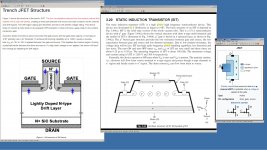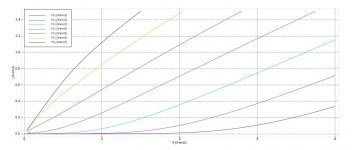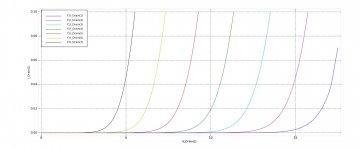Infineon SIC jfets are buried gate but pricey and EOL, you may still be able to buy some leftover IJW120R100T1 from Mouser.
United SIC UJ3N jfets are trench gate, mbrennwa traced the UJ3N065080K3S The Zenitron thread post #134, Vgs <= 8.5V curves looks interesting enough.
Hi Indra1
In posts 153 and 155 of the Zenitron thread you will see that I performed due diligence on that part and posted the results. My conclusion is that there is no triode-like behavior with the UJ3N part. I went down to the very lowest drain current. What you can clearly see is that this part has a very large positive tempco which appears as triode-ish rise. True SIT parts do not have the pentode quasi-sat shoulder shown in post 153.
The Infineon device datasheet has a good set of curves. If there were SIT behavior, you would not see the flat area in saturation. The true SIT devices never settle into the flat saturation behavior even when there is positive gate voltage.
So, I am waiting for someone to point out a JFET that has the same triode-ish behavior of the LU1014.
Sorry, I missed your conclusion there.
No worries. I appreciate your inputs. Your designs and builds are all interesting.
I am looking for any device besides the LU1014 that is advertised as a JFET and has triode-ish curves anywhere. If there are none, I believe that it bolsters my assertion that the LU1014 is an SIT where we audio circuit builders care. What it does at 50A is mostly irrelevant to me.
What would be the downside to confusing the two?
...
Unless you have firsthand knowledge of the structure of the LU1014 you cannot say for certain that it is not an SIT marketed as a JFET.
To me, the harm is potentially spreading misinformation. I have no knowledge of the structure of the LU1014 and make no claim that it isn't a SIT, but by your logic, you also cannot claim that it is a SIT unless you have such knowledge.
To me, the harm is potentially spreading misinformation. I have no knowledge of the structure of the LU1014 and make no claim that it isn't a SIT, but by your logic, you also cannot claim that it is a SIT unless you have such knowledge.
An SIT is a specific type of JFET. The LU1014 datasheet states that the LU1014 is a power JFET. My personal measurements show that the LU1014 has triode-like curves at low-ish currents and high-ish voltages; the same way that 2SK60 has triode-like curves at low-ish currents and high-ish voltages.
I have found no other JFET that has any triode-like curves the way that the LU1014 has triode-like curves.
My suspicion is that the LU1014 structure is SIT-ish either by accident or on purpose and for whatever reason not disclosed in the datasheet.
That is my logic.
How about 'Beast of a Dozen Power JFETS'
To make optimum use of the LU1014's, you should use it in a Triode Cell.
This is essentially the lower half of Fig. 4 :
Zen Variations 9 | Pass DIY
The problem of using this as a source follower is it's high Zout, about 1R at 1.3A bias.
One can reduce this to about 0.5R by using a modulated current source, as in the DAO TCS.
The DAO SE all-FET Class-A ZGF Headphone Amplifier
Taylor Source Follower
That is of course not particularly low, with a damping factor of only 16 for 8 ohm.
But then the M2 also has a Zout of ~0.5R and that didn't stop people from rushing to it.
So maybe worth a try.
And you only need a pair of LU1014 per channel. 😉
Cheers,
Patrick
The triode cell of the LU1014 at 1.3A was a brainchild of Nelson, not me.
You can read about this in detail in Zen V8 :
Zen Variations 8 | Pass DIY
Patrick
You can read about this in detail in Zen V8 :
Zen Variations 8 | Pass DIY
Patrick
LU1014 Power Amps
So suddenly there is so much interest with the LU1014, that people asked me about things from 15 years ago.
Things that I no longer remember.
Here are a couple where the LU1014 triode cell is being used to replace the IRF240.
Aleph J Schematic
FirstWatt J2
Of course the J2 is a simpler and more "modern" version of modulated CS than the Aleph.
I built the first one a decade ago, but not the second.
So build at own risk.
Aleph J Schematic
There are more that I experimented with LU1014s over the years.
You just need to use the advance search with my Username and LU1014 as keyword.
Happy surfing, 😉
Patrick
So suddenly there is so much interest with the LU1014, that people asked me about things from 15 years ago.
Things that I no longer remember.
Here are a couple where the LU1014 triode cell is being used to replace the IRF240.
Aleph J Schematic
FirstWatt J2
Of course the J2 is a simpler and more "modern" version of modulated CS than the Aleph.
I built the first one a decade ago, but not the second.
So build at own risk.
Aleph J Schematic
There are more that I experimented with LU1014s over the years.
You just need to use the advance search with my Username and LU1014 as keyword.
Happy surfing, 😉
Patrick
A picture is worth 1000 words.
If you are convinced that they are the same, then that's all that matters I suppose. I don't see any merit in pursuing this further.
If you are convinced that they are the same, then that's all that matters I suppose. I don't see any merit in pursuing this further.
I never said that they are identical. #1 and #2 are very similar. #3 is similar to neither #1 nor #2. The LU1014D in particular traces triode-like curves the same as all of my collection SITs; 2SK60, 2SK18, 2SK182, etc.
From a cursory search, I find no other power trench JFET available to purchase anywhere other than the LU1014D. If there are no others, the LU1014D is a unicorn.
Have you read Mr. Pass's Zen V8 article? I quote him here
"In the case of JFET part LU1014, we note that with a gate voltage of –1 volt, the curve is concave below about 5 amps and 4 volts. In this range it has that triode character, and this is the area of interest to us here."
The LU1014D datasheet does not show any curves where audio designers would be interested. I have done so and attached are the curves for low currents. Looks like all of my SITs.
Attachments
Yes, I have read all of his Zen articles. I don't disagree about the triode-like curves at all, and I never said I did. I've traced them myself. They are a rarity in solid state devices, and are what make the LU1014 special. Like I said above, this is not a fruitful discussion as it doesn't seem we agree on which topic we disagree about, and I really don't care to pursue this any further. LU1014 is a very interesting part. We should all probably build something with it.
Yes, I have read all of his Zen articles. I don't disagree about the triode-like curves at all, and I never said I did. I've traced them myself. They are a rarity in solid state devices, and are what make the LU1014 special. Like I said above, this is not a fruitful discussion as it doesn't seem we agree on which topic we disagree about, and I really don't care to pursue this any further. LU1014 is a very interesting part. We should all probably build something with it.
Your post #54 in this thread is the reason for the exchange. I pursued it because noobs read these threads. I have had PM traffic stating as much.
As a conclusion from me with respect to your post #54 in this thread, I state that I cannot prove that the LU1014 is an SIT. What I state is that it behaves exactly like all of the SITs in my collection and that no other JFET that I know of behaves like an SIT. If someone wants to experiment with an SIT, the LU1014 is a great device to get your hands on. At the moment, they are available on the surplus market. Grab some while you can. I have no financial interest in any supplier of LU1014.
...I pursued it because noobs read these threads. I have had PM traffic stating as much...
And that's the reason I posted in the first place. Stating things we cannot prove as facts can mislead people who are new to the topic.
any reliable supplier of LU1014 ?
I have a few matched pairs...how many are you looking for?
- Home
- Amplifiers
- Pass Labs
- Pictures of a >>GENUINE<< Lovoltech LU1014D Wanted!


